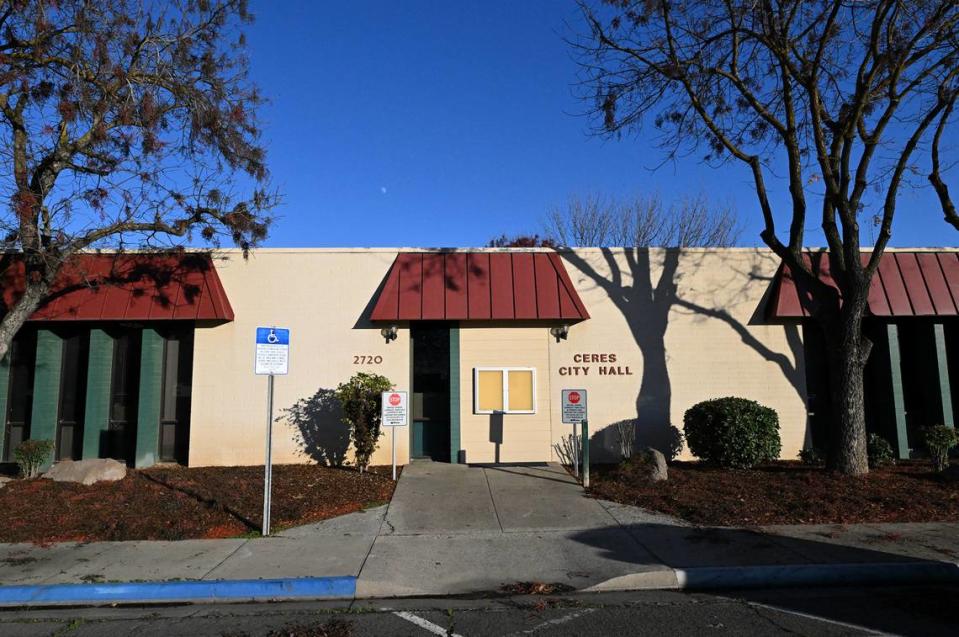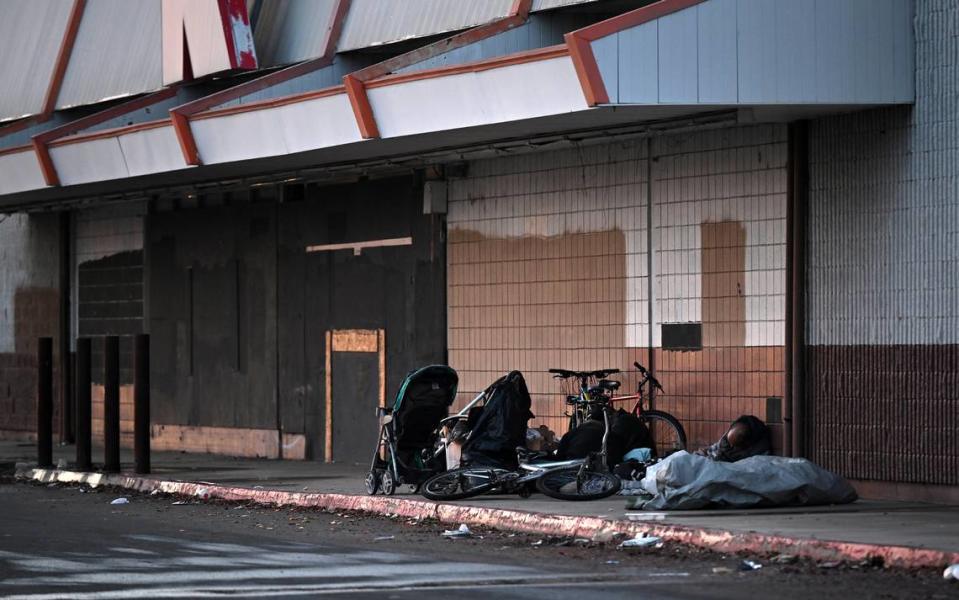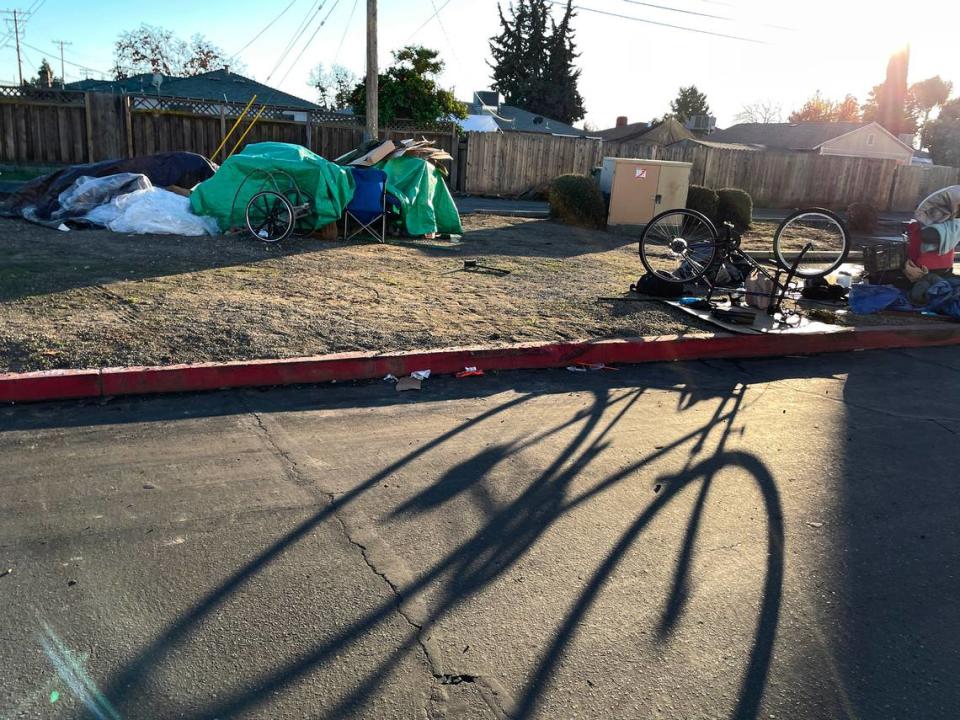Ceres bans homeless camps near ‘critical infrastructure.’ What is City Council’s next step?
Starting in mid-January, Ceres will ban camping and the storing of personal property within 25 feet of what it deems critical infrastructure, joining other cities that have passed similar ordinances in response to the homelessness crisis.
The question the City Council still has to answer is what constitutes critical infrastructure.
Some cities across the state have said the answer includes schools, parks, government buildings, sidewalks, homes, water treatment plants, bridges and fire stations.
Ceres City Attorney Nubia Goldstein said in an interview that her recommendation to the council will be that it limit critical infrastructure to city-owned facilities. She said cities enter a gray area in the law when they designate infrastructure they don’t own as critical.
The City Council approved the critical infrastructure ordinance on a 3-2 vote at its Nov. 13 meeting. On a 4-1 vote at the same time, it OK’d a companion ordinance that allows the city to remove camping sites within 25 feet of critical infrastructure with 72 hours notice — though the city can take immediate action if the conditions warrant it.
Both ordinances received their second and final approvals at the council’s Dec. 11 meeting and take effect 30 days after that. Goldstein said from a practical standpoint, the ordinances won’t be enforced until the council comes up with a list of infrastructure.

Coming up with list of critical sites
That could happen at the council’s Jan. 22 meeting, but it’s more likely to happen at the council’s Feb. 12 meeting, City Manager Doug Dunford said. Goldstein said staff from such departments as engineering, parks and recreation and public works will work on coming up with recommendations.
Ceres like other California cities faces a growing crisis with homelessness, including limited services and housing, as well as encampment-related blight and public health hazards.
Dunford said in an interview that the two ordinances are not an attempt to move homeless people from site to site or to push them out of the city. He said the ordinances come as Ceres looks at how it can provide a more comprehensive approach to homelessness.
A 2018 9th Circuit Court of Appeals ruling in Martin v. Boise found that cities can’t make it a crime for people to sleep on public property when they don’t have a viable alternative, such as a bed in a shelter. But cities can regulate camping at particular locations and during particular times, according to Goldstein.
She said the two ordinances comply with Martin v. Boise and strike a balance between protecting the due process rights of people who are homeless and maintaining a safe, healthy community.

“The idea behind them, the premise, is to protect certain areas,” Goldstein said. “We know that we cannot prohibit or outlaw homelessness.”
Interim Police Chief Chris Perry gave the council at its Dec. 11 meeting an update on his department’s efforts to deal with homelessness.
He said code enforcement had cleared and cleaned 216 homeless encampments from Sept. 1 through Nov. 26. The city takes this action after posting a notice, Perry said. Workers picked up 18,328 pounds of debris and returned 227 shopping carts to stores.
Forming homeless outreach team?
Perry said at the Nov. 13 meeting that code enforcement often deals with the same people at these encampments, who then “pop up” at another location.
He said the Police Department is looking at forming its own version of Modesto’s Community Health and Assistance Team. CHAT outreach specialists work with homeless people on getting services and off the streets.
Perry said Ceres would look to apply for state funding in January for what he called a homeless outreach team. He said it would consist of a supervisor, crime analyst and two outreach workers.
In an interview, Dunford said Ceres is discussing with Stanislaus County and Modesto how to bring more services to people who are homeless in Ceres.
He said that could include Ceres having its own version of a Downtown Streets Team. The Bay Area-based nonprofit operates in 20 communities, including Modesto, and provides work, case management and a path out of homelessness. Dunford stressed this is a proposal and would require City Council approval.
Council members James Casey and Rosalinda Vierra cast the two “no” votes at Nov. 13 meeting against the critical infrastructure ordinance. Casey also voted against the second ordinance, while Vierra voted in support of it.

Vierra said at the Nov. 13 meeting that the ordinance as written is too broad and could ban camping anywhere in the city. “This is basically making homelessness illegal,” she said, “and that goes against Boise.”
Goldstein said at the Nov. 13 meeting that the council is engaged in a two step process, with the ordinance as the first step. The next step will be to come up with the list of critical infrastructure.
Vierra said in an interview that she’d have liked a list of critical infrastructure when the council approved the ordinance. She still has concerns it will have too many sites and violate the Boise decision.
A key in trying to make a difference with homelessness in Ceres is more services, Vierra said, adding that part of her campaign for council in the November 2022 election was the creation of a homeless outreach team.
“I’ve been homeless before,” Vierra said, recalling the two weeks in December 1994 that she and her 2-year-old daughter spent in a budget hotel room in Modesto provided by the county.
Vierra, 49, said the county then helped get her and her daughter into an affordable triplex. Vierra said she now has a master’s degree and works as a student success specialist at Modesto Junior College.
“None of this would have been possible for me if I didn’t have help when I was at the bottom,” she said. “If you really want help, I want to make sure we offer that help. Not all want help. We have to figure out how to address the people who don’t want out of homelessness.”

